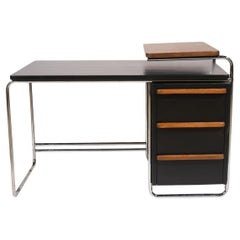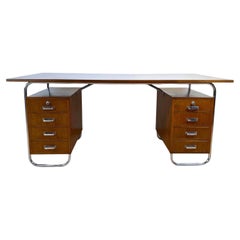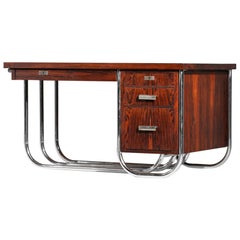Howell Case Pieces and Storage Cabinets
to
1
Height
to
Width
to
Depth
to
1
1
1
1
1
1
1
1
1
1
1
1
1
1
3
373
343
207
177
Creator: Howell
Deco Bauhaus chrome 3 drawer desk by Wolfgang Hoffmann Desk for Howell
By Howell, Wolfgang Hoffmann
Located in Brooklyn, NY
Deco Bauhaus chrome 3 drawer desk by Wolfgang Hoffmann Desk for Howell. Bent chrome tube structure with 3 drawers. Good vintage condition for its age shows wear and use to chrome and...
Category
1930s American Bauhaus Vintage Howell Case Pieces and Storage Cabinets
Materials
Chrome
$2,880 Sale Price
20% Off
Related Items
Bauhaus Desk by Mücke-Melder, Steeltubes and Oak Veneer, Czechia circa 1935
By Marcel Breuer, Mücke & Melder
Located in Regensburg, DE
Beautiful, large modernist Bauhaus Steeltube Desk by Mücke-Melder, Czechia circa 1935.
Oak solid wood and veneer. Chrome-plated, polished tubular steel frame with original patina.
Left and right each 4 long drawers. By locking the top drawer all 4 drawers are locked.
Very functional with much storage space and very good legroom. The desk can also be used as a 'partners desk' and be worked on from two sides.
In the style of Marcel Breuer’s steel tube desks...
Category
1930s Czech Bauhaus Vintage Howell Case Pieces and Storage Cabinets
Materials
Steel
$9,429
H 30.71 in W 68.9 in D 35.44 in
Modernist Desk in Solid Wood 40s / 50s Bauhaus Style Vintage
Located in Ternay, Auvergne-Rhône-Alpes
French desk from the 40s / 50s in modernist Bauhaus style. Structure of the desk in veneered and solid Rio rosewood with a triple tubular base in chromed steel quite rare. The desk i...
Category
1940s French Bauhaus Vintage Howell Case Pieces and Storage Cabinets
Materials
Chrome
Studio BBPR for Olivetti Sintesis "Arco" Office 3-Drawer Desk, Italy 1960s
By Olivetti, Studio BBPR
Located in Naples, IT
Desk Mod. "Arco" designed by Studio BBPR for Olivetti Sintesis in 1963. The desk has an iron frame and base on one side and has a case containing 3 drawers and the original metal was...
Category
1960s Italian Mid-Century Modern Vintage Howell Case Pieces and Storage Cabinets
Materials
Iron
$3,342
H 31.5 in W 27.56 in D 55.12 in
Restored Bauhaus Desk, Erich Dieckmann, Lacquered Rosewood, Germany circa 1925
By Bauhaus, Erich Dieckmann
Located in Regensburg, DE
Original, fully restored Bauhaus Desk, attributed to Erich Dieckmann, Germany, 1923-1925 at the Bauhaus in Weimar.
Wonderful rosewood / Palisander veneer with excellent piano lacquer...
Category
1920s German Bauhaus Vintage Howell Case Pieces and Storage Cabinets
Materials
Stainless Steel, Nickel
$10,623
H 31.11 in W 63.39 in D 31.5 in
Art Deco Wolfgang Hoffmann Romweber World's Fair Century of Progress Sideboard
By Wolfgang Hoffmann, Romweber Furniture Co.
Located in Forney, TX
A rare and important American Art Deco Century of Progress Sideboard by iconic designer Wolfgang Hoffmann (Austrian, 1900-1969) for Romweber Company, Batesville, Indiana. circa 1933-1936
Created for the 1933 Chicago World's Fair, fine quality craftsmanship and construction, having a rectangular exotic rosewood veneered top over conforming solid wood case fitted with four drawers affixed with horizontal pulls, the top drawer opening to reveal felt lined divided interior for silverware, flanked by cabinet doors opening to shelved interior, subtle geometric lines add interest. Rosewood, mahogany, richly figured blonde - golden birch or primavera.
Signed, top drawer interior, featuring 1933 World's Fair mark impressed.
**Please note, at the time of writing this, a matching display case - vitrine cabinet (shown in last photo) is currently available separately**
Provenance / Acquisition:
Property from the important and iconic Collection of Mr. James I. Rafftesaeth Jr., Dallas, Texas
Acquired from highly reputable auction house, Heritage Auctions, Dallas, Texas. 2022 Design Signature Auction catalog #8091
History:
Wolfgang Hoffmann was born in Vienna, Austria in 1900. He is the son of famous architect, pedagogue and Wiener Werkstatte cofounder, Joseph Hoffmann (1870-1956). Early on, following his father’s s interests, he was trained in the decorative arts and design. Wolfgang Hoffmann once reminisced, “I spent eight years at the Realschule, then three years went to a special architectural school, where I perfected my technical knowledge of architecture and general construction. From this school, I was graduated to the Kunstgewerbeschule [Studying under Oskar Strnad and Josef Frank in Vienna]. After finishing this school, I had one and a half years of practical in a well known architect’s office. Thereafter I worked in my Father’s office for two years”.
Hoffmann met his future wife, Polish immigrant Pola (1902-1984) when they were both studying at the Kunstgewerbeschule. Joseph Urban (1872-1933) was needing an assistant for his architectural business in New York and contacted his friend and colleague, Joseph Hoffmann in Vienna. Hoffmann recommended his son Wolfgang. Urban hired him and sent a first class passage ticket to Vienna for Wolfgang to travel to New York. Wolfgang married Pola and traded his ticket for two tickets to America in steerage, arriving in New York City in December of 1925.
Leaving the Urban office after nine months, Wolfgang and Pola formed an independent design practice with offices on Madison Avenue in Manhattan with the purpose of creating contemporary interiors and industrial designs. Early work included theaters, stores, and apartments mostly in New York City.
During the late 1920’s and early 1930’s the Hoffmanns designed custom furniture for private clients. Some of these examples were shown in the February 1929 issue of House and Garden. Curiously, the examples’ design was attributed to Urban and the production to Pola Hoffmann, Inc.
Established in the fall of 1928, the American Designers’ Gallery was “devoted exclusively to showing objects and interiors for practical use… by fourteen American architects and designers”. Its members included the Hoffmans and Urban as well as ceramist Henry Varnum Poor (1888-1971), architect Raymond Hood (1881-1934), artist designer Winold Reiss (1886-1953), graphic designer Lucien Bernhard (1896-1981), decorator Donald Deskey (1894-1989), and architect Ely Jacques Kahn (1884-1972).
The Hoffmanns’ work was included in the American Designers’ Gallery’s two showcase events, its 1928 and 1929 exhibitions. Their dining alcove at the 1929 event featured a bench with a dinette table and two chairs in American walnut designed by Wolfgang and a rug by Pola.
Lucien Bernhard, fellow Austrian immigrant who settled in New York a year before the Hoffmanns, operated the gallery and decorating service Contempora with Munich resident Bruno Paul (1874-1968). The Hoffmanns, occasionally participating with Contempora, designed a number of outstanding interiors, including the constructivist living room of 1930 for Mrs. O.R. Sommerich at 40 East 66th street. In 1934, Donald Deskey commissioned Wolfgang to design birchwood furnishings for the eclectic apartment at 625 Park Avenue belonging to Helena Rubinstein.
In 1931, Wolfgang exhibited his work at the Pennsylvania Art Museum and the Museum of Modern Art in New York City. The same year, with Kem Weber (1889-1963) he organized the second and final exhibition of AUDAC- “Modern Industrial and Decorative Arts”- at the Brooklyn Museum. At this event, the Hoffmanns showed the dining room previously included in the American Designer’s Gallery’s 1929 exhibition in the Chase Bank Building lobby at 145 West 57th Street in Manhattan.
In 1932 Wolfgang was asked to assist Urban in developing the color scheme for the 1933-34 Chicago World’s Fair “A Century of Progress”. He was also commissioned to design the interior and furniture for the fair’s lumber industries house. There he executed its living and dining rooms furnished by Kroehler Manufacturing Company of Chicago; the boys’ room by Shower Brothers...
Category
Early 20th Century American Art Deco Howell Case Pieces and Storage Cabinets
Materials
Birch, Mahogany, Rosewood
$9,500
H 30 in W 49 in D 20 in
Modern Karl Springer Style Three-Drawer Faux Shagreen Desk/Writing Table, Chrome
By Karl Springer
Located in Manhasset, NY
Modern Karl Springer style three-drawer faux Shagreen desk on a chrome plated x form base.
Sleek desk or writing table in a Springer style finish w...
Category
1980s Unknown Vintage Howell Case Pieces and Storage Cabinets
Materials
Chrome
$3,300
H 30 in W 48 in D 25.5 in
Vintage John Stuart White Lacquered Campaign Wood Desk X-Chrome Base Two Drawer
By West Michigan Furniture Co., John Stuart
Located in North Miami, FL
This newly restored vintage John Stuart campaign 2 drawer desk and or writing desk is white lacquered over wood with chrome handles and 2 X-frame ...
Category
1970s American Modern Vintage Howell Case Pieces and Storage Cabinets
Materials
Chrome
$6,240 Sale Price
20% Off
H 28.5 in W 54 in D 24.5 in
Art Deco Solid Oak Single Drawer Sculpted Curves Two-Tier Desk / Console
Located in Los Angeles, CA
Solid oak desk with sculpted curves and a two-tier work top. This desk is art deco era, dated circa 1930's-1940's. The piece has been refinished and shows very well. A single dovetail drawer on the front. Could be used as a small sideboard or entry way console.
Desk dimensions...
Category
1930s American Art Deco Vintage Howell Case Pieces and Storage Cabinets
Materials
Oak
$2,400
H 38.5 in W 32 in D 16.5 in
Art Deco Signed Wolfgang Hoffmann for Romweber World's Fair Display Cabinet
By Romweber Furniture Co., Wolfgang Hoffmann
Located in Forney, TX
A rare and important Art Deco period Century of Progress Display Cabinet designed by Wolfgang Hoffmann (Austrian, 1900-1969) for Romweber Company, Batesville, Indiana, United States of America. circa 1933-1936
Created for the 1933 Chicago World's Fair, one piece design, having a rectangular showcase top with glass panel sides and a pair of sliding glass doors, over solid wood chest fitted with four drawers affixed with horizontal pulls, flanked by cabinet doors, opening to shelved interior. Rosewood, mahogany, richly figured blonde - golden birch or primavera, and glass.
Signed, original label to drawer interior, featuring 1933 World's Fair mark impressed.
**Please note, at the time of writing this, a matching sideboard - buffet (shown in last photo) is currently available separately**
Provenance / Acquisition:
Property from the important and iconic collection of Mr. James I. Rafftesaeth Jr., Dallas, Texas
Acquired from highly reputable auction house, Heritage Auctions, Dallas, Texas. 2022 Design Signature Auction catalog #8091
History:
Wolfgang Hoffmann was born in Vienna, Austria in 1900. He is the son of famous architect, pedagogue and Wiener Werkstatte cofounder, Joseph Hoffmann (1870-1956). Early on, following his father’s s interests, he was trained in the decorative arts and design. Wolfgang Hoffmann once reminisced, “I spent eight years at the Realschule, then three years went to a special architectural school, where I perfected my technical knowledge of architecture and general construction. From this school, I was graduated to the Kunstgewerbeschule [Studying under Oskar Strnad and Josef Frank in Vienna]. After finishing this school, I had one and a half years of practical in a well known architect’s office. Thereafter I worked in my Father’s office for two years”.
Hoffmann met his future wife, Polish immigrant Pola (1902-1984) when they were both studying at the Kunstgewerbeschule. Joseph Urban (1872-1933) was needing an assistant for his architectural business in New York and contacted his friend and colleague, Joseph Hoffmann in Vienna. Hoffmann recommended his son Wolfgang. Urban hired him and sent a first class passage ticket to Vienna for Wolfgang to travel to New York. Wolfgang married Pola and traded his ticket for two tickets to America in steerage, arriving in New York City in December of 1925.
Leaving the Urban office after nine months, Wolfgang and Pola formed an independent design practice with offices on Madison Avenue in Manhattan with the purpose of creating contemporary interiors and industrial designs. Early work included theaters, stores, and apartments mostly in New York City.
During the late 1920’s and early 1930’s the Hoffmanns designed custom furniture for private clients. Some of these examples were shown in the February 1929 issue of House and Garden. Curiously, the examples’ design was attributed to Urban and the production to Pola Hoffmann, Inc.
Established in the fall of 1928, the American Designers’ Gallery was “devoted exclusively to showing objects and interiors for practical use… by fourteen American architects and designers”. Its members included the Hoffmans and Urban as well as ceramist Henry Varnum Poor (1888-1971), architect Raymond Hood (1881-1934), artist designer Winold Reiss (1886-1953), graphic designer Lucien Bernhard (1896-1981), decorator Donald Deskey (1894-1989), and architect Ely Jacques Kahn (1884-1972).
The Hoffmanns’ work was included in the American Designers’ Gallery’s two showcase events, its 1928 and 1929 exhibitions. Their dining alcove at the 1929 event featured a bench with a dinette table and two chairs in American walnut designed by Wolfgang and a rug by Pola.
Lucien Bernhard, fellow Austrian immigrant who settled in New York a year before the Hoffmanns, operated the gallery and decorating service Contempora with Munich resident Bruno Paul (1874-1968). The Hoffmanns, occasionally participating with Contempora, designed a number of outstanding interiors, including the constructivist living room of 1930 for Mrs. O.R. Sommerich at 40 East 66th street. In 1934, Donald Deskey commissioned Wolfgang to design birchwood furnishings for the eclectic apartment at 625 Park Avenue belonging to Helena Rubinstein.
In 1931, Wolfgang exhibited his work at the Pennsylvania Art Museum and the Museum of Modern Art in New York City. The same year, with Kem Weber (1889-1963) he organized the second and final exhibition of AUDAC- “Modern Industrial and Decorative Arts”- at the Brooklyn Museum. At this event, the Hoffmanns showed the dining room previously included in the American Designer’s Gallery’s 1929 exhibition in the Chase Bank Building lobby at 145 West 57th Street in Manhattan.
In 1932 Wolfgang was asked to assist Urban in developing the color scheme for the 1933-34 Chicago World’s Fair “A Century of Progress”. He was also commissioned to design the interior and furniture for the fair’s lumber industries house. There he executed its living and dining rooms furnished by Kroehler Manufacturing Company of Chicago; the boys’ room by Shower Brothers...
Category
Early 20th Century American Art Deco Howell Case Pieces and Storage Cabinets
Materials
Glass, Mahogany, Rosewood
$9,500
H 66.75 in W 47.5 in D 19.5 in
Desk by Jens Risom, Blonde Wood, Blue Drawer Fronts, Chrome Pulls, Laminate Top
By Jens Risom
Located in Kansas City, MO
Jens Risom desk for Risom Designs. Birch wood case, light blue lacquered drawer fronts, chrome pulls, brass feet, and virtually indestructible Laminate top. Condition is good and com...
Category
1960s American Mid-Century Modern Vintage Howell Case Pieces and Storage Cabinets
Materials
Brass, Chrome
$4,850
H 29 in W 54 in D 30 in
1960s Arco Office 3-Drawer Desk by Studio BBPR for Olivetti Sintesis
By Studio BBPR, Olivetti
Located in Philadelphia, PA
This is an Arco desk, designed by Studio B.B.P.R for Olivetti Sintesis in 1963. The piece was manufactured in Italy in the 1960s. The frame and base are made of iron, and it has a ca...
Category
1960s Italian Modern Vintage Howell Case Pieces and Storage Cabinets
Materials
Iron
$6,000
H 30.71 in W 70.87 in D 33.86 in
France Desk Art Deco, 1920, Materials, Wood and Chrome
Located in Ciudad Autónoma Buenos Aires, C
French desk style: Art Deco
Year 1920
Material: Wood and chrome
It is an elegant and sophisticated dream desk.
The quality of the furniture and the exotic wood used make it unique. ...
Category
1920s French Art Deco Vintage Howell Case Pieces and Storage Cabinets
Materials
Wood
Howell case pieces and storage cabinets for sale on 1stDibs.
Howell case pieces and storage cabinets are available for sale on 1stDibs. These distinctive items are frequently made of wood and are designed with extraordinary care. There are many options to choose from in our collection of Howell case pieces and storage cabinets, although brown editions of this piece are particularly popular. Prices for Howell case pieces and storage cabinets can differ depending upon size, time period and other attributes — on 1stDibs, these items begin at $3,600 and can go as high as $3,600, while a piece like these, on average, fetch $3,600.


